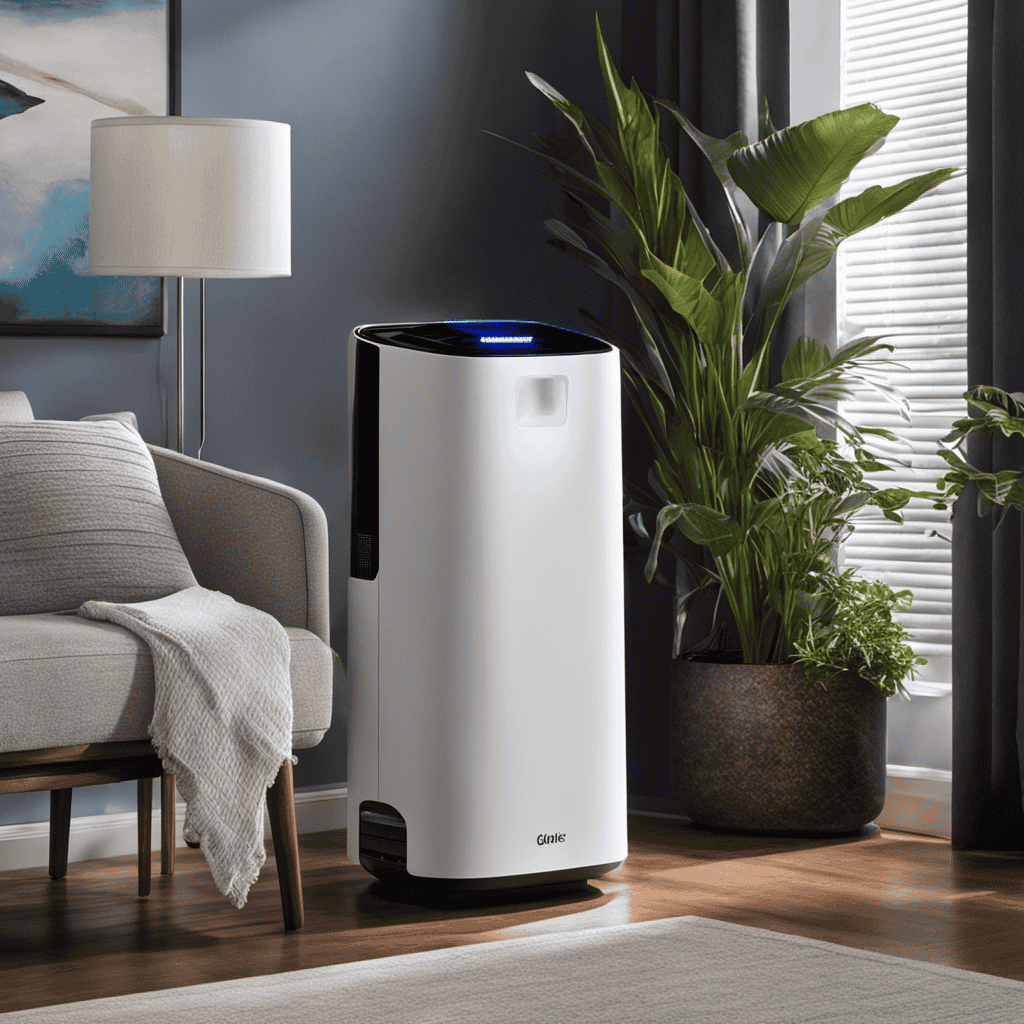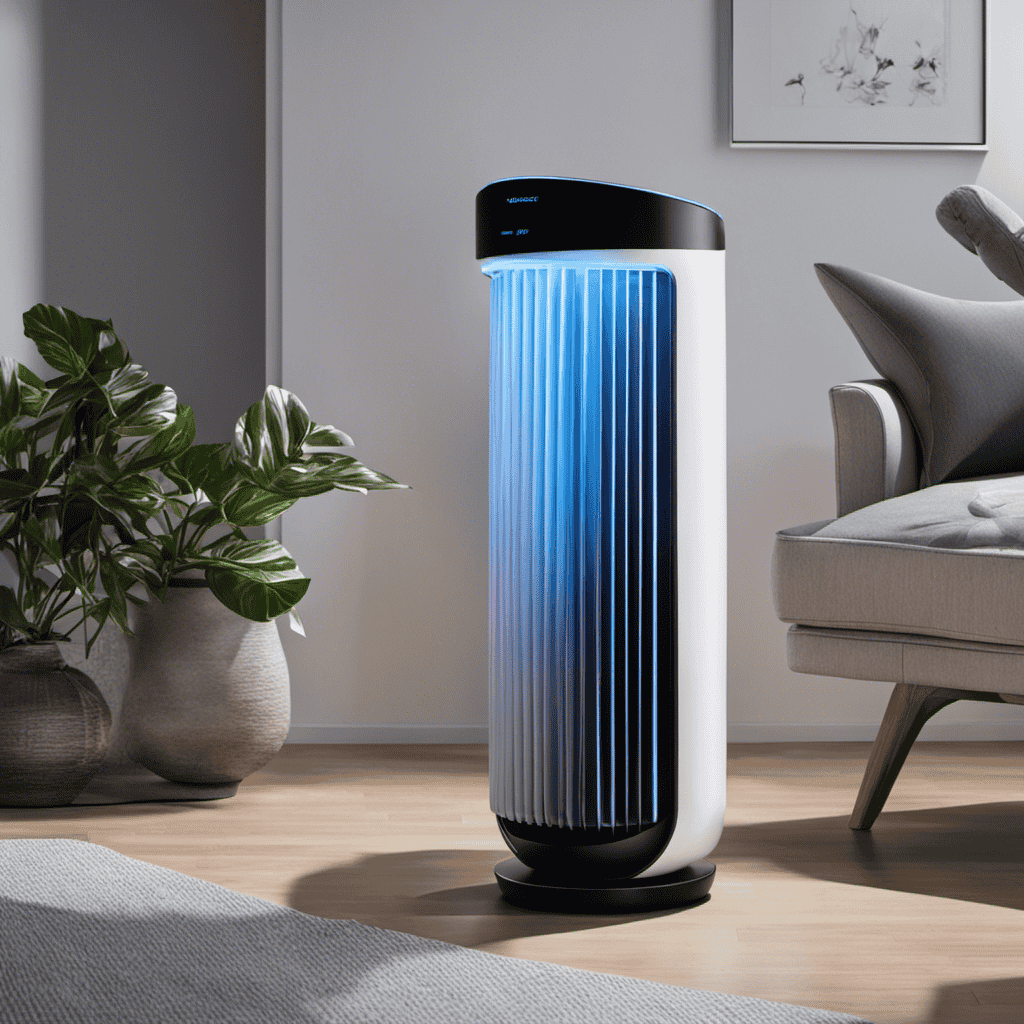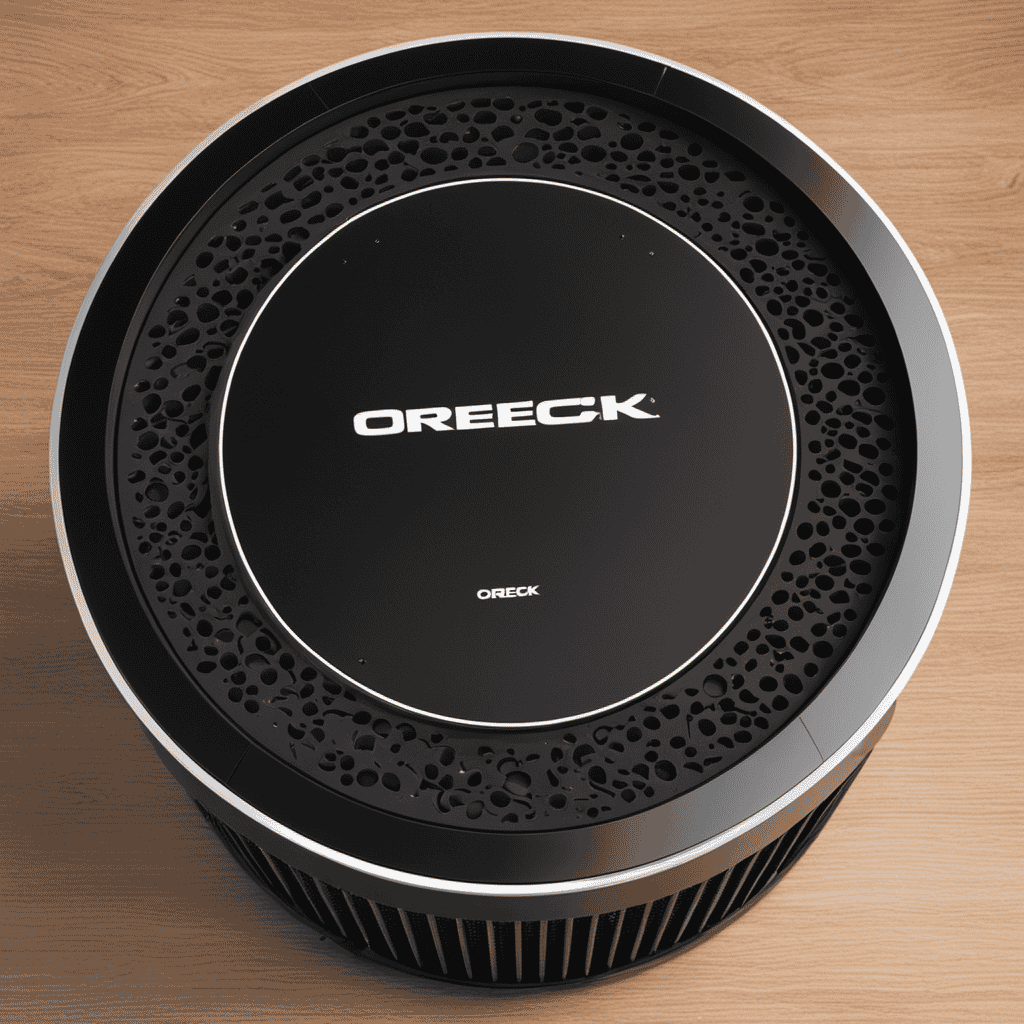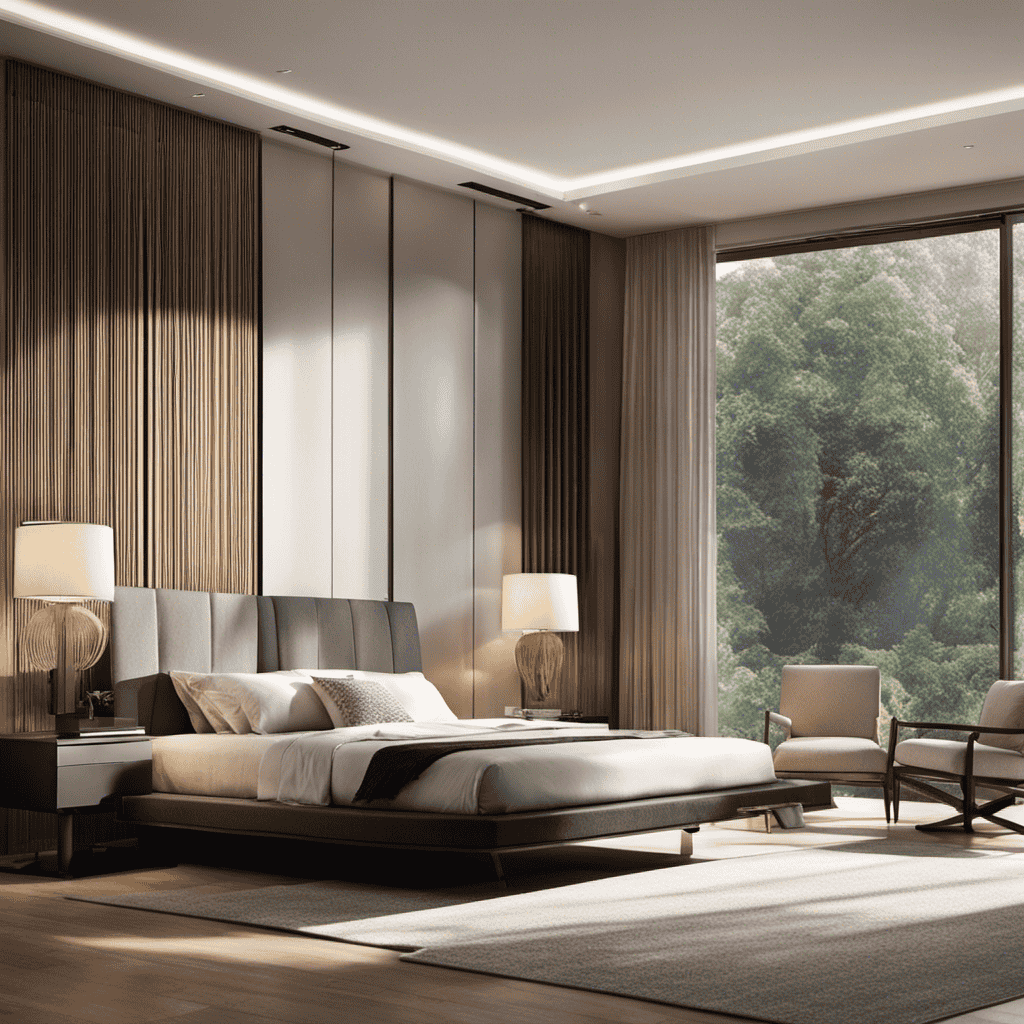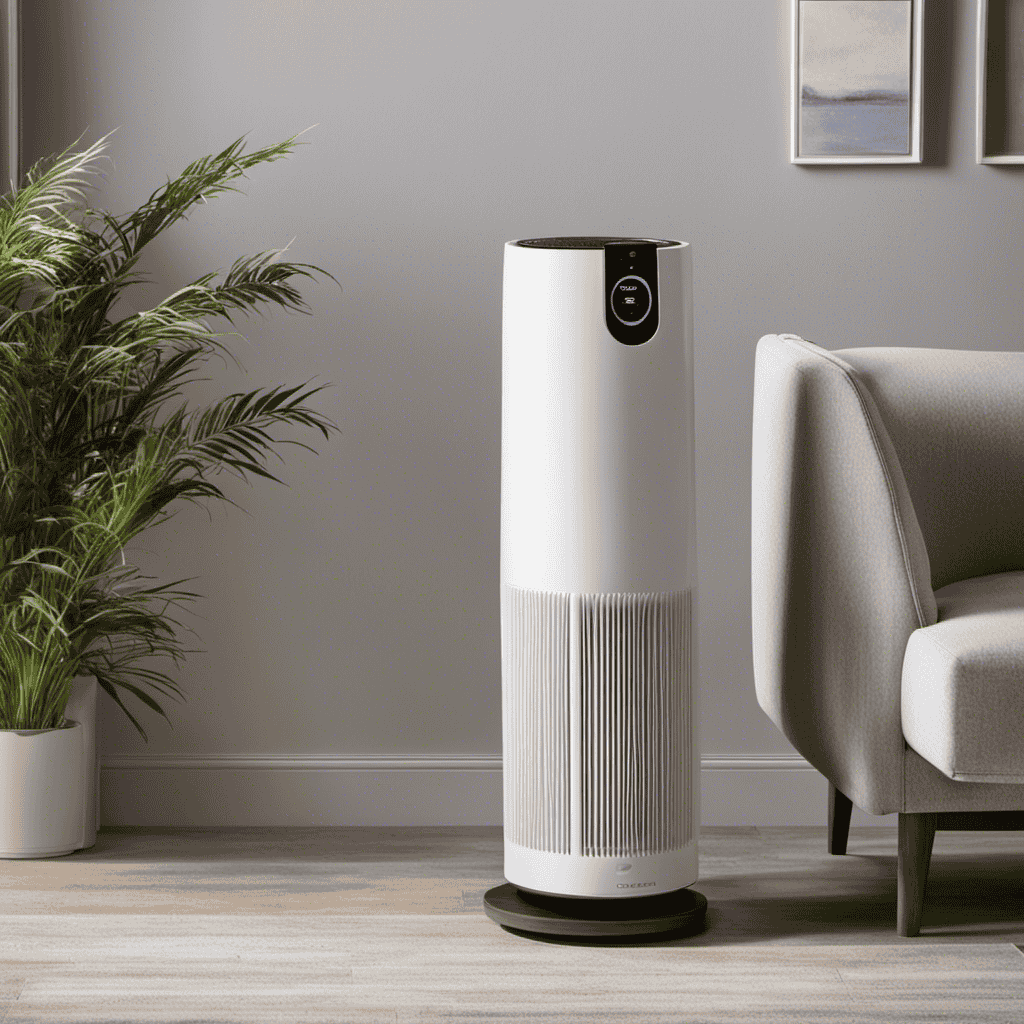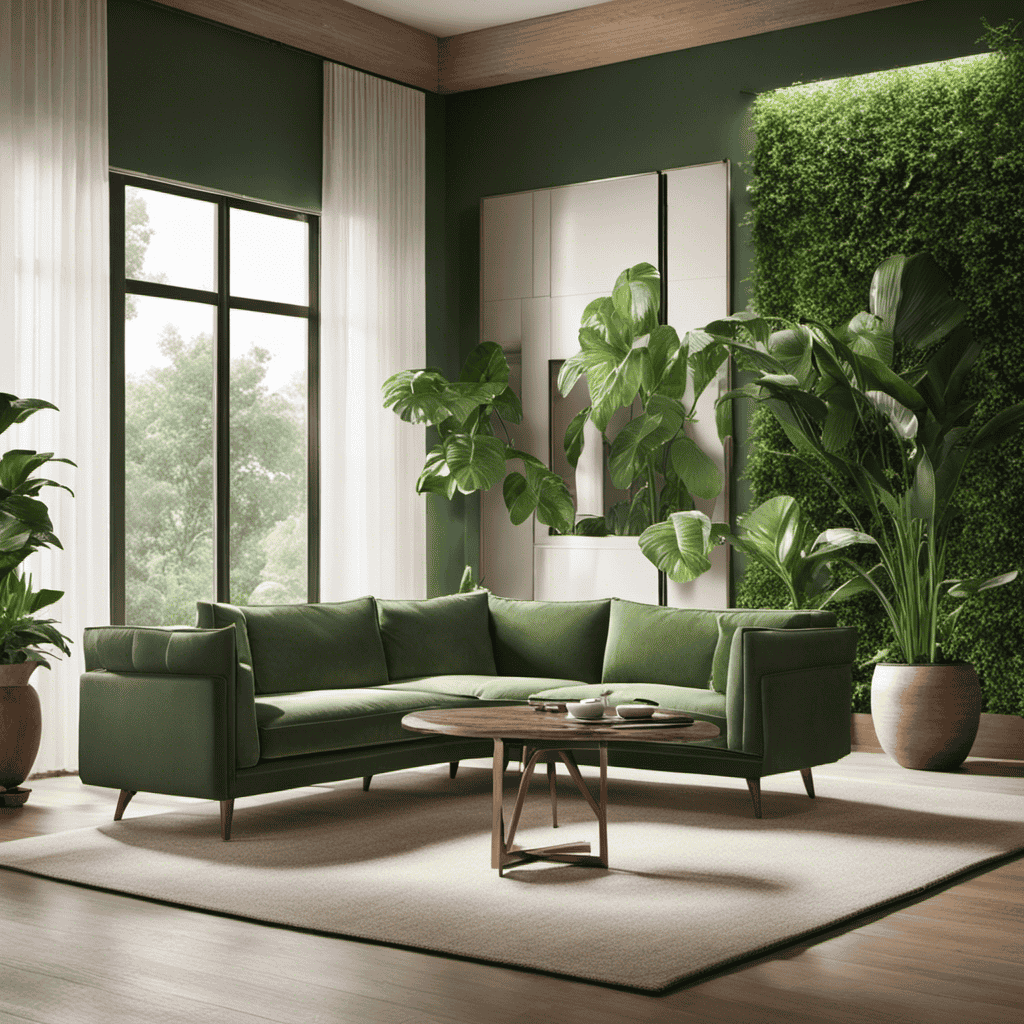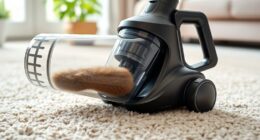I have always been worried about the air quality in my home, especially with all the pollutants and pathogens circulating. That is why I chose to purchase a UV-C air purifier.
UV-C technology uses powerful ultraviolet light to eliminate harmful germs and bacteria, creating a healthier environment. In this article, I’ll delve into the fascinating world of UV-C air purifiers, explaining how they work, their benefits, and what to consider when choosing one.
Get ready to breathe cleaner, fresher air with the help of UV-C technology.
Key Takeaways
- UV-C technology uses powerful ultraviolet light to eliminate harmful germs and bacteria.
- UV-C light has a wavelength between 200 and 280 nanometers, which damages the DNA and RNA of microorganisms, preventing them from reproducing.
- UV-C air purifiers effectively kill bacteria, viruses, and mold spores, improving indoor air quality and reducing the risk of respiratory illnesses and allergies.
- Factors such as room size, air exchange rate, noise level, energy efficiency, and low maintenance should be considered when choosing a UV-C air purifier for optimal performance and user satisfaction.
Understanding UV-C Technology
To understand UV-C technology, you’ll need to know how it works to kill bacteria and viruses in the air. UV-C air purifiers have gained popularity, especially during the COVID-19 pandemic, as they claim to effectively eliminate harmful pathogens.
The main advantage of UV-C technology is its ability to destroy microorganisms without the use of chemicals, making it a safe and eco-friendly option. These air purifiers work by emitting short-wavelength ultraviolet light that damages the DNA and RNA of bacteria and viruses, rendering them unable to reproduce or cause harm.
However, there are some drawbacks to UV-C technology. One limitation is that it only works on surfaces directly exposed to the light, so it may not be as effective in removing contaminants in hidden or hard-to-reach areas. Additionally, prolonged exposure to UV-C light can be harmful to humans, causing skin and eye damage.
Despite these cons, UV-C air purifiers remain a promising solution in the fight against airborne pathogens. Now, let’s delve deeper into how UV-C light kills pathogens.
How UV-C Light Kills Pathogens
You can understand how UV-C light eliminates harmful bacteria and viruses. UV-C light is a type of ultraviolet light that has a wavelength between 200 and 280 nanometers. This specific wavelength is effective in killing pathogens because it damages the DNA and RNA of microorganisms, preventing them from reproducing and causing infections. UV-C light is particularly effective against viruses, including the ones that cause the common cold, flu, and even COVID-19. This makes UV-C air purifiers an excellent choice for hospitals, where the risk of infection transmission is high. These air purifiers use UV-C lamps to continuously disinfect the air, ensuring a safer and healthier environment for patients and healthcare workers. The benefits of UV-C air purifiers for hospitals are numerous, as shown in the table below:
| Benefits of UV-C Air Purifiers for Hospitals |
|---|
| Reduces airborne transmission of viruses |
| Kills harmful bacteria and fungi |
| Improves indoor air quality |
| Enhances infection control measures |
The Benefits of Using a UV-C Air Purifier
Using a UV-C air purifier has numerous benefits. It improves indoor air quality and eliminates harmful microorganisms. The UV-C light technology effectively kills bacteria, viruses, and mold spores, ensuring a healthier environment. By eliminating these harmful microorganisms, the purifier helps reduce the risk of respiratory illnesses and allergies. This makes it an excellent choice for those looking to enhance their overall well-being.
Improved Indoor Air Quality
Indoor air quality can be greatly improved with the use of a UV-C air purifier. One of the main factors that contribute to poor air quality is inadequate ventilation. By using a UV-C air purifier, it helps to enhance the ventilation system by eliminating harmful microorganisms and purifying the air.
Additionally, air quality testing is an essential step in determining the level of pollutants present in the indoor environment. This testing can identify specific pollutants and their concentrations, allowing for targeted improvements to be made.
UV-C air purifiers are effective in reducing airborne bacteria, viruses, and mold spores, which can all contribute to health issues and allergies. By eliminating these harmful microorganisms, the air becomes cleaner and safer to breathe, promoting a healthier environment for everyone.
Eliminates Harmful Microorganisms
An UV-C air purifier eliminates harmful microorganisms, making the air cleaner and safer to breathe. The benefits of UV-C air purifiers are numerous, especially when it comes to their effectiveness against viruses. Here are three key reasons why UV-C air purifiers are so effective:
-
Germicidal UV-C Technology: UV-C light has been proven to be highly effective in destroying viruses, bacteria, and other harmful microorganisms. The intense UV-C light damages the DNA and RNA of these microorganisms, preventing them from replicating and causing harm.
-
Continuous Air Disinfection: Unlike other air purifiers that simply filter the air, UV-C air purifiers actively disinfect the air by continuously emitting UV-C light. This ensures that any microorganisms present in the air are constantly being neutralized, providing a safer and healthier indoor environment.
-
Comprehensive Air Purification: UV-C air purifiers not only eliminate viruses and bacteria, but also remove other airborne pollutants such as allergens, mold spores, and odors. This comprehensive purification process ensures that the air you breathe is free from a wide range of contaminants.
Different Types of UV-C Air Purifiers
There are various types of UV-C air purifiers available on the market. Different brands of UV-C air purifiers offer a range of features and technologies to effectively eliminate harmful microorganisms in hospitals and healthcare facilities.
UV-C air purifiers use ultraviolet light to kill bacteria, viruses, and molds, providing a cleaner and healthier environment. Some brands utilize advanced filtration systems in combination with UV-C technology to capture and eliminate airborne particles as small as 0.3 microns. These air purifiers can also help reduce allergens, odors, and volatile organic compounds (VOCs) in the air.
Additionally, UV-C air purifiers are designed to be energy-efficient and low maintenance, making them a cost-effective solution for hospitals and healthcare facilities. When choosing a UV-C air purifier, factors such as room size, air exchange rate, and noise level should be considered to ensure optimal performance and user satisfaction.
Factors to Consider When Choosing a UV-C Air Purifier
When choosing a UV-C air purifier, you should consider factors such as room size, air exchange rate, and noise level to ensure optimal performance and user satisfaction.
-
Room Size: It is important to choose an air purifier that is suitable for the size of the room you want to purify. A purifier that is too small may not effectively clean the air, while one that is too large may consume unnecessary energy.
-
Air Exchange Rate: The air exchange rate indicates how many times the purifier can filter the air in a room per hour. A higher exchange rate means better air purification. It is recommended to choose a purifier with at least 4-6 air changes per hour for optimal results.
-
Noise Level: Some air purifiers can be noisy, especially at higher fan speeds. It is important to choose a purifier that operates at a noise level that is tolerable for your specific needs, especially if you plan to use it in a bedroom or office.
Considering these factors will help you select a UV-C air purifier that suits your needs and provides the benefits of cleaner and healthier air.
UV-C Air Purifier Vs. Traditional Air Purifiers
The main difference between UV-C air purifiers and traditional ones is the method of air purification they employ. Traditional air purifiers use filters to trap and remove particles from the air. In contrast, UV-C air purifiers use ultraviolet light to kill airborne germs and bacteria.
This difference in technology leads to several key benefits of UV-C air purifiers. Firstly, they are highly effective in eliminating harmful pathogens, including viruses and mold spores. Secondly, UV-C air purifiers do not produce any harmful byproducts, such as ozone, making them safe for continuous use. Lastly, these air purifiers are low maintenance, as there is no need to replace filters.
On the other hand, traditional air purifiers can be effective in removing larger particles like dust and pollen, but may not be as efficient in eliminating germs and bacteria.
Transitioning into the subsequent section about ‘UV-C air purifiers and allergies’, it is important to note that UV-C air purifiers can also help alleviate allergy symptoms by eliminating allergens from the air.
UV-C Air Purifiers and Allergies
When it comes to UV-C air purifiers and allergies, there are several key points to consider.
Firstly, UV-C light has been shown to be highly effective against allergens such as dust mites, pollen, and pet dander. This can greatly benefit allergy sufferers by reducing the presence of these triggers in the air they breathe.
However, it is important to note that UV-C air purifiers may also have potential side effects, such as ozone production, which can be harmful in high concentrations.
UV-C Effectiveness Against Allergens
UV-C air purifiers are effective at reducing allergens in the air. These devices use ultraviolet light to kill or neutralize harmful microorganisms, including viruses and bacteria. When it comes to respiratory infections, UV-C air purifiers can play a crucial role in preventing the spread of airborne viruses.
Here are three reasons why UV-C air purifiers are effective against allergens:
-
Eliminates allergens: UV-C light has the ability to break down the DNA of allergens, rendering them harmless. This includes common allergens such as pollen, pet dander, and dust mites.
-
Reduces airborne particles: UV-C air purifiers can capture and remove tiny particles from the air, including allergens. This helps to create a cleaner and healthier indoor environment.
-
Prevents mold growth: Mold spores are a common trigger for allergies. UV-C light can inhibit the growth of mold and prevent it from spreading, reducing the risk of allergic reactions.
With their ability to effectively combat allergens, UV-C air purifiers offer numerous benefits for allergy sufferers.
Benefits for Allergy Sufferers
Improve your indoor air quality and reduce allergy symptoms with the benefits of using a UV-C air purifier.
UV-C air purifiers are highly effective in eliminating allergens from the air, providing relief for allergy sufferers. The UV-C light emitted by these purifiers has the ability to kill bacteria, viruses, and mold spores, which are major triggers for allergies. The effectiveness of UV-C air purifiers lies in their ability to destroy the DNA of these microorganisms, rendering them harmless.
By removing these allergens from the air, UV-C air purifiers can help alleviate symptoms such as sneezing, coughing, and watery eyes. Additionally, these purifiers can also reduce the risk of respiratory infections and improve overall air quality in your home.
Investing in a UV-C air purifier is a smart choice for anyone looking to minimize their exposure to allergens and create a healthier living environment.
Potential Side Effects
To avoid potential side effects, it’s important to follow the manufacturer’s instructions and use the UV-C air purifier as directed. While UV-C air purifiers are effective in eliminating harmful pathogens and allergens from the air, they do come with some potential long-term effects.
One of the main concerns is skin sensitivity. The UV-C light emitted by these devices can cause skin irritation and sensitivity if not used properly. Here are three important points to consider regarding potential side effects:
-
Time and exposure: Prolonged exposure to UV-C light can lead to skin damage. It’s crucial to limit the amount of time spent in direct contact with the purifier and ensure it’s placed in an area where people do not spend significant amounts of time.
-
Distance and positioning: Keeping a safe distance from the UV-C purifier is crucial. Placing it in a location where it doesn’t directly shine on the skin can minimize the risk of skin sensitivity.
-
Protective measures: Wearing protective clothing, such as long sleeves and gloves, can provide an extra layer of protection against potential skin sensitivity caused by UV-C light.
UV-C Air Purifiers and Asthma
Using UV-C air purifiers can help alleviate asthma symptoms. Asthma is a chronic respiratory condition that can be triggered by various factors, including air pollution. UV-C air purifiers are designed to eliminate harmful particles and microorganisms from the air, reducing the risk of asthma attacks. These purifiers use ultraviolet light to target and destroy bacteria, viruses, and mold spores that can worsen respiratory health. By incorporating UV-C technology into air purification systems, these devices can effectively remove allergens and pollutants from indoor environments, improving air quality and reducing asthma symptoms. Here is a table showcasing the benefits of UV-C air purifiers for respiratory health:
| Benefits of UV-C Air Purifiers |
|---|
| Removes allergens and pollutants from the air |
| Reduces the risk of asthma attacks |
| Eliminates bacteria, viruses, and mold spores |
| Improves indoor air quality |
| Alleviates asthma symptoms |
With their ability to target and eliminate harmful particles, UV-C air purifiers are a valuable tool for individuals with asthma, providing relief and improving overall respiratory health.
UV-C Air Purifiers and Pet Dander
By incorporating a UV-C air purifier into your home, you can effectively reduce pet dander and improve your indoor air quality. Pet dander, which consists of tiny flecks of skin shed by animals, can easily become airborne and cause allergies or respiratory issues for pet owners. UV-C air purifiers are specifically designed to target and eliminate these allergens, providing a healthier environment for both you and your furry friend.
Here are three reasons why UV-C air purifiers are effective in reducing pet dander:
-
UV-C light technology: UV-C light has been proven to destroy the DNA of microorganisms, including pet dander. As the air passes through the purifier, the UV-C light kills the dander, preventing it from circulating in the air.
-
HEPA filtration: Many UV-C air purifiers also come equipped with HEPA filters, which are highly efficient at trapping and removing pet dander particles from the air.
-
Odor elimination: Along with pet dander, UV-C air purifiers can also help eliminate pet odors, leaving your home smelling fresh and clean.
Overall, UV-C air purifiers are a great investment for pet owners looking to create a healthier living environment for themselves and their pets.
UV-C Air Purifiers and Mold Spores
In my previous subtopic, I discussed how UV-C air purifiers can effectively remove pet dander from indoor air. Now, let’s explore another important benefit of these purifiers: their ability to tackle mold spores. Mold spores are tiny particles that can cause various respiratory issues when inhaled. UV-C air purifiers are equipped with ultraviolet lights that can destroy these spores, preventing them from spreading and causing respiratory infections.
To understand the effectiveness of UV-C air purifiers in removing mold spores, let’s take a look at the following table:
| Mold Spore Removal | |
|---|---|
| UV-C Air Purifiers | Highly Effective |
| Other Air Purifiers | Moderately Effective |
| No Air Purifier | Ineffective |
As you can see, UV-C air purifiers are highly effective in removing mold spores, making them a valuable tool in maintaining indoor air quality. Additionally, these purifiers also help eliminate indoor odors, creating a fresh and clean environment.
UV-C Air Purifiers and Cigarette Smoke
Let’s explore how UV-C air purifiers can effectively tackle cigarette smoke and improve indoor air quality. When it comes to secondhand smoke, UV-C air purifiers are a powerful tool in reducing its harmful effects. Here’s why:
-
Elimination of Smoke Particles: UV-C air purifiers use ultraviolet light to neutralize and destroy the smoke particles in the air. This process helps to remove the odor and hazardous substances present in cigarette smoke.
-
Advanced Filtration System: Alongside the UV-C technology, these air purifiers also incorporate filters that capture and trap smoke particles, including the smallest ones that are often the most harmful.
-
Odor Removal: UV-C air purifiers not only eliminate smoke particles but also help to remove the lingering odor caused by cigarettes. The combination of UV-C light and filtration effectively neutralizes the odor, leaving the indoor air fresh and clean.
UV-C Air Purifiers and Vocs (Volatile Organic Compounds
UV-C air purifiers are effective at reducing VOCs, which are harmful chemicals commonly found in indoor air. VOCs, or Volatile Organic Compounds, are emitted from various sources such as cleaning products, paints, furniture, and even personal care items. These chemicals can contribute to poor indoor air quality and can cause health issues such as headaches, dizziness, and respiratory problems.
UV-C air purifiers use ultraviolet light to break down and neutralize these VOCs, helping to eliminate their presence in the air. In addition to reducing VOCs, UV-C air purifiers are also effective at eliminating chemical odors that may be present in indoor spaces. By targeting and neutralizing these indoor pollutants, UV-C air purifiers create a healthier and more comfortable living environment.
To ensure the continued effectiveness of a UV-C air purifier, proper maintenance is essential.
How to Properly Maintain a UV-C Air Purifier
Regular maintenance is crucial for keeping a UV-C air purifier operating effectively. Here are some common mistakes to avoid and troubleshooting tips to ensure your device is always in top condition:
-
Clean the filters regularly: Neglecting to clean or replace the filters can significantly reduce the purifier’s efficiency. Follow the manufacturer’s instructions for proper maintenance.
-
Check the UV-C lamp: The UV-C lamp is responsible for killing bacteria and viruses. If the lamp is not functioning properly, it may not effectively sanitize the air. Regularly inspect the lamp and replace it if necessary.
-
Keep the unit clean: Dust and debris can accumulate on the exterior of the purifier, hindering its performance. Wipe down the unit regularly with a damp cloth and ensure that the air intake and exhaust vents are clear of obstructions.
Safety Precautions When Using a UV-C Air Purifier
When it comes to using a UV-C air purifier, there are several important factors to consider.
First, it’s crucial to follow proper usage guidelines to ensure maximum effectiveness and safety.
Additionally, there are potential health risks associated with UV-C air purifiers, so it’s important to be aware of these and take necessary precautions.
Proper Usage Guidelines
To ensure optimal performance, it’s important to follow proper usage guidelines for your UV-C air purifier. Here are some common mistakes to avoid and effective cleaning techniques to keep in mind:
-
Positioning: Place the air purifier in a central location within the room to ensure maximum coverage. Avoid blocking the airflow by keeping it away from walls or furniture.
-
Maintenance: Regularly clean the filters and UV-C lamp according to the manufacturer’s instructions. This helps maintain the efficiency of the purifier and ensures effective air purification.
-
Timer settings: Use the timer function to control the operation of the air purifier. Set it to run for a certain duration based on the room size and air quality.
Potential Health Risks
It’s essential to be aware of potential health risks associated with UV-C air purification.
While UV-C air purifiers offer numerous health benefits, such as destroying harmful microorganisms and reducing airborne allergens, it is crucial to understand the potential dangers they pose.
One of the main concerns is the emission of ozone, a harmful gas that can irritate the respiratory system and cause lung damage.
Additionally, prolonged exposure to UV-C light can harm the skin and eyes, leading to sunburns, premature aging, and even an increased risk of skin cancer.
It is important to use UV-C air purifiers with caution, ensuring proper ventilation and avoiding direct exposure to the light.
Regular maintenance and following the manufacturer’s guidelines are also crucial to minimize potential health risks.
Maintenance and Cleaning
After discussing the potential health risks associated with UV-C air purifiers, it is important to understand the maintenance and cleaning required to keep these devices functioning effectively. Proper cleaning is crucial to ensure optimal performance and prevent the buildup of harmful contaminants. Here are some key steps to follow:
-
Regular cleaning: Wipe down the exterior of the purifier with a damp cloth to remove dust and dirt. This will prevent clogging and maintain the device’s efficiency.
-
Filter replacement: UV-C air purifiers usually come with replaceable filters. Check the manufacturer’s recommendations for the frequency of filter replacement. This will ensure that the purifier continues to effectively remove pollutants from the air.
-
Deep cleaning: Periodically, perform a deep cleaning by removing the filter and cleaning it according to the manufacturer’s instructions. This will help to remove any trapped particles or debris that may have accumulated over time.
Common Misconceptions About UV-C Air Purifiers
You might think that UV-C air purifiers are harmful, but they are actually safe for use when following the manufacturer’s instructions.
One of the common misconceptions about UV-C air purifiers is that they emit harmful levels of radiation. However, UV-C air purifiers use a specific type of ultraviolet light called UV-C, which is known to have germicidal properties.
These purifiers work by emitting short-wavelength UV-C light that damages the DNA of microorganisms, rendering them unable to reproduce and causing them to die. This UV-C light is contained within the purifier and does not escape into the surrounding environment, making it safe for humans and pets.
In fact, UV-C air purifiers have been proven to be effective in reducing the concentration of airborne bacteria, viruses, and mold spores.
Frequently Asked Questions
Can a UV-C Air Purifier Be Used in All Rooms of the House?
Yes, a UV-C air purifier can be used in all rooms of the house. They are effective in reducing airborne viruses and bacteria by using UV-C light to kill them.
How Long Does It Take for a UV-C Air Purifier to Kill Pathogens in the Air?
It typically takes a UV-C air purifier a few hours to effectively kill pathogens in the air. The efficiency of UV-C air purifiers depends on factors like room size, air circulation, and the intensity of the UV-C light.
Are UV-C Air Purifiers Safe to Use Around Children and Pets?
UV-C air purifiers are safe to use around children and pets. They effectively reduce airborne allergens and provide potential health benefits by eliminating pathogens in indoor spaces.
Can a UV-C Air Purifier Remove Odors From the Air?
Yes, a UV-C air purifier can effectively remove odors from the air. The UV-C light kills bacteria and viruses that cause odors, providing the added benefit of fresh and clean-smelling air in your home.
Do UV-C Air Purifiers Require Any Special Installation or Setup?
Installation requirements and setup process for UV-C air purifiers may vary depending on the specific model. However, in general, they are relatively easy to install and require minimal setup.
Conclusion
To summarize, the UV-C air purifier is an exceptional device that harnesses the power of UV-C technology to eliminate harmful pathogens and improve indoor air quality. Its ability to neutralize airborne contaminants and odors is truly remarkable.
However, it is important to consider various factors when selecting the right UV-C air purifier for your needs. Additionally, proper maintenance and adherence to safety precautions are crucial for optimal performance.
Don’t be swayed by common misconceptions; instead, embrace the effectiveness and sophistication of UV-C air purifiers for a healthier living environment.
